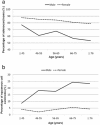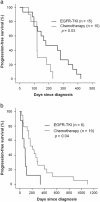Advanced non-small cell lung cancer in patients aged 45 years or younger: outcomes and prognostic factors
- PMID: 22695392
- PMCID: PMC3420246
- DOI: 10.1186/1471-2407-12-241
Advanced non-small cell lung cancer in patients aged 45 years or younger: outcomes and prognostic factors
Abstract
Background: Lung cancer in young patients (less or equal to 45 years) is uncommon and has clinical characteristics different from that in older patients. We investigated the outcomes and prognostic factors of young patients with advanced non-small cell lung cancer (NSCLC).
Methods: From January 2000 to December 2009, we enrolled patients aged ≤45 years and diagnosed with stage IIIB or IV NSCLC. Their clinical data, including age, gender, performance status, histologic types, disease stages, laboratory data at diagnosis, treatment modalities, and survival were reviewed and analyzed. A Cox proportional hazard model was used to calculate the hazard ratio (HR) and its 95% confidence interval (CI).
Results: A total of 144 patients with advanced NSCLC were included. Female patients were more prevalent (n = 74, 51.4%). Adenocarcinoma was the most common histologic type (n = 119, 82.6%) in both genders (male, n = 54, 77.1%; female, n = 65, 87.8%). Epidermal growth factor receptor (EGFR) sequences were determined using tumor specimens from 58 patients, and 29 showed an EGFR mutation. No significant difference in median survival was found between patient groups with and without the EGFR mutation (798 vs. 708 days, p = 0.65). In multivariate analysis, male gender (HR, 1.70; 95% CI: 1.08-2.68), body mass index (BMI) less than 25 kg/m(2) (HR, 2.72; 95% CI: 1.39-5.30), stage IV disease (HR, 2.62; 95% CI: 1.50-4.57), and anemia (HR, 2.08; 95% CI: 1.15-3.77) were associated with a short survival time.
Conclusions: Low BMI, stage IV disease, anemia at diagnosis, and male gender were the negative prognostic factors for young patients with advanced NSCLC.
Figures



References
-
- Coleman MP, Forman D, Bryant H, Butler J, Rachet B, Maringe C, Nur U, Tracey E, Coory M, Hatcher J. et al.Cancer survival in Australia, Canada, Denmark, Norway, Sweden, and the UK, 1995–2007 (the International Cancer Benchmarking Partnership): an analysis of population-based cancer registry data. Lancet. 2011;377(9760):127–138. doi: 10.1016/S0140-6736(10)62231-3. - DOI - PMC - PubMed
-
- Berrino F, De Angelis R, Sant M, Rosso S, Bielska-Lasota M, Coebergh JW, Santaquilani M. Survival for eight major cancers and all cancers combined for European adults diagnosed in 1995–99: results of the EUROCARE-4 study. Lancet Oncol. 2007;8(9):773–783. doi: 10.1016/S1470-2045(07)70245-0. - DOI - PubMed
-
- Subramanian J, Morgensztern D, Goodgame B, Baggstrom MQ, Gao F, Piccirillo J, Govindan R. Distinctive characteristics of non-small cell lung cancer (NSCLC) in the young: a surveillance, epidemiology, and end results (SEER) analysis. J Thorac Oncol. 2010;5(1):23–28. doi: 10.1097/JTO.0b013e3181c41e8d. - DOI - PubMed
MeSH terms
Substances
LinkOut - more resources
Full Text Sources
Medical
Research Materials
Miscellaneous

